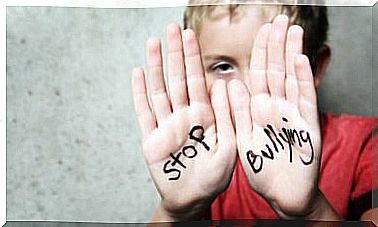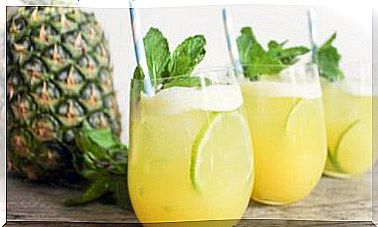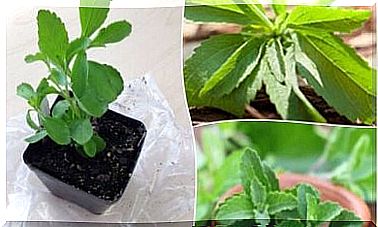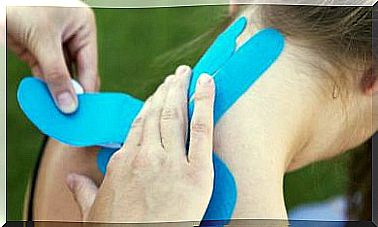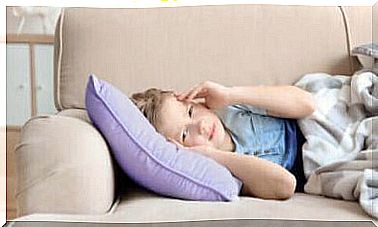Description, Characteristics And Benefits Of Gua Sha

Gua sha is a technique in traditional Chinese medicine that is about 2000 years old. Gua means to scrape, and sha means sand. We also know this as “kerokan”.
During this treatment, a therapist will scrape the skin with a flat stone of jade or quartz. Nowadays, it is part of alternative or natural treatment. The goal is to help deal with some health issues. This is because it helps soothe muscles, relieve pain, promote tissue drainage and improve blood circulation.
People have also started using it for aesthetic reasons such as as a treatment for anti-aging as it seems to reduce wrinkles.
Tools for gua sha
A stone of jade or quartz is the primary tool for the gua sha technique and is typically shaped like a heart.
There are different shapes for different parts of the body. For example, some resemble fish, others resemble the foot of a bird, while others are elongated. In addition to this, there are massage rollers of jade and also facial oils and moisturizing creams.
The benefits of gua sha
These have not been scientifically studied in depth, although its proponents claim that it can successfully treat various ailments. They depend on the type of stone.
For example, jade has sedative properties, and quartz helps reduce inflammation, improve blood circulation, and stimulate drainage of the lymphatic system.
Migraine, arthritis and pain in the neck and back
Gua sha is traditionally used to treat symptoms of various inflammatory disorders as well as chronic pain. In addition, some claim that it helps relieve migraines as well as pain in the neck and back that has come from poor posture.
Massage with gua sha techniques relieves muscle tension. According to research, it was an effective treatment for chronic pain in the neck compared to other techniques – such as heating pads.
A clinical study also suggested its effectiveness in treating migraines even in patients who do not respond to over-the-counter pain medications.

Perimenopause and swollen breasts
Perimenopause is a series of symptoms that occur in women approaching the age before menopause. Among the most common are the following:
- Irregular periods of sleep.
- Absent or violent menstruation and dysmenorrhea.
- Anxiety.
- Chronic fatigue.
- A feeling of being suffocated.
However, one study found that gua sha may help reduce the symptoms of perimenopause in some women. They have also been used to treat swollen breasts.
Thus, research indicates that women who receive gua sha massage after childbirth are less likely to suffer from clogged mammary glands. This significantly improves the breastfeeding process.
Aesthetic purposes
At present, most focus is on using gua sha for aesthetic purposes. People use it as an anti-aging treatment as it apparently reduces wrinkles and tightens the skin.
For these purposes, people perform gua sha on the back, buttocks, arms and legs of a person. They also use it as a facial massage. The goal is to stimulate blood circulation and help absorb the products used.
Contraindications
Gua sha is a natural, non-invasive treatment and thus it is safe. However, rubbing or scratching the skin with massage stones can lead to bruising that disappears after a few days.
However, there are some contraindications:
- It is not suitable for people who have recently undergone surgery, especially not if it is in the area being massaged.
- It is not suitable for people with coagulation problems or those undergoing a blood-thinning treatment, as the use of this technique can destroy some small blood vessels.
- Lastly, do not rub on injuries such as blows, wounds, edema or thrombi.
How to perform gua sha
The gua sha technique must be performed by someone who is properly trained and has experience with this technique. The stone should slide upwards and only in one direction when massaging the body. The same goes for the face. Let’s look at some examples:
- Neck: They start at the bottom and make movements upwards as well as from the inside out using the heart-shaped side and with a slightly stronger pressure at the bottom.
- The face: They move from the cheek and out towards the ear, where they follow the shape of the face with the same side of the stone. They apply a light pressure at the end of the movement.
- Cheekbones: They make several movements from the nose and out towards the cheekbones and from the cheekbones and out towards the ears, where they also put a light pressure on at the end of each movement.
- The area around the nose and lips: Here they make diagonal movements from the tip of the lip towards the chin and also towards the tip of the eyebrows.
- The eyes: To do this, the therapist starts at the eyebrows and in a way makes a line towards the temples by using the heart-shaped side of the stone and maintaining an upward movement.
- Forehead and between the eyebrows: The therapist applies a light pressure with the curved side of the stone by moving from between the eyebrows and towards the hairline.

Proven effects
Gua sha treatment has no scientific basis according to its opponents. There is no doubt that massage tightens muscles and increases blood flow, but one can say that it happens no matter how one does it. Some say that the stone is not necessary, so its effects are not because of it.
However, several studies revealed that gua sha helps reduce the intensity of neck pain in patients after just one week of use. Another study indicates that this technique helps patients regain mobility and flexibility and reduces their need for painkillers.
Most recently, a study conducted at Beijing University used gua sha to activate the immune response and reduce inflammation in mice infected with PR8. This technique inhibited the infiltration of inflammation. However, it is a controlled study that was only performed on animals.
Gua sha in the evening and without makeup
The stone of jade or quartz adapts to the curves of the skin to stimulate as long as the therapist performs the movements correctly.
Other recommendations one should keep in mind are that it is best to perform gua sha on a clean, moisturized face after removing makeup. Doing so in the evening before going to bed not only delays aging, but it also soothes the muscles.

